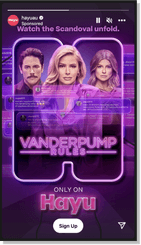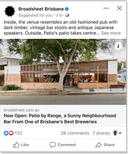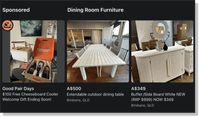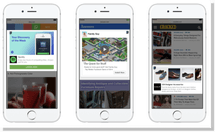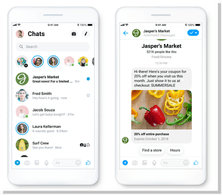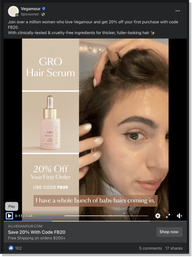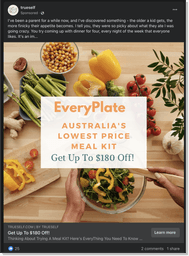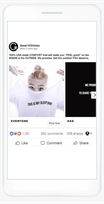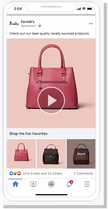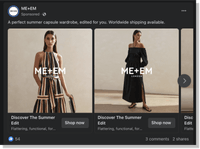
6 Benefits of Using Meta Ads to Advertise Your Business
Meta Ads offers the potential to scale your business to new heights with cost-effective ads and precise targeting options to endless creative possibilities and measurable results,
In a competitive online world now inundated with flashy sales and advertisements, staying relevant and capturing the attention of your target audience is an ongoing challenge.
Meta Ads (previously Facebook Ads) is a type of online advertising where businesses can create customised ads and target specific audiences on Meta (Facebook) and Instagram.
It helps businesses reach a wide range of potential customers, increase brand awareness, drive website traffic and, most importantly, drive action on your website like leads and sales.
With different campaign objectives, ad formats, media buying tactics, and detailed metrics, businesses can measure their ad performance and optimise their campaigns to drive more performance continually.
This article aims to break down the 6 main benefits of using Meta Ads and how they can help scale your business to the moon! 🚀🌝
Meta Ads Benefit #1 – Ad Costs 💰
Let’s begin by talking about the cost of Meta Ads. Compared to other platforms like Google Ads, Microsoft Ads or LinkedIn, Meta Ads, if managed with best practices, can produce cheaper CPCs.
Meta Ads operates on a CPM (Cost-Per-Thousand Impressions) model where advertisers are charged based on the number of impressions or views their ads receive per thousand. This differs from Google, where advertisers are charged per click or engagement.
You can improve the CPM cost by:
- Ensuring you create ads that resonate with your audience. Pay attention to your click-through rate (CTR)
- Manage the frequency at which your ads are shown to users. While it’s essential to maintain visibility, excessive ad frequency may lead to ad fatigue and decreased engagement rates and, as such, higher CPMs.
- Regular A/B testing – iterate on your top-performing ads instead of always creating brand-new angles.
- Ensure your landing pages are well-optimised for a positive user experience. The landing page should be relevant to the ad content, load quickly, and provide clear calls to action.
- Include an audience size that is not too specific or broad.
Audience definition insights when building a new audience
The CPM model offers several benefits for advertisers on Meta.
- Brand Visibility: Advertisers can achieve significant brand exposure by reaching a large audience and displaying their ads to thousands of users. This can be particularly valuable for campaigns focused on brand awareness, as advertisers pay for ad impressions regardless of user interaction.
- Cheaper CPCs: As previously mentioned, if you can create compelling creative that speaks to your customer’s wants and needs, you can likely drive cheaper CPCs than other major ad platforms.
When it comes to budget allocation, Meta has two options:
- Lifetime Budget: This allows you to set a specific budget for a specific date range. This means Meta’s in the driver’s seat and will spend the budget as best as possible based on its learnings. This can be a good option for smaller monthly budgets.
- Daily Budget: This option allows you to set a specific budget for each day. Meta will then look to spend that entire budget within 24 hours. This option gives you more control over when you spend the budget.
We also have two further options for budget allocation, CBO and ABO.
- [CBO] Campaign Budget Optimisation – This will allow you to set a budget on a campaign level and let Meta divvy the budget between the adsets. This can be good for testing audiences.
- [ABO] Adset Budget Optimisation – This allows you to set the budgets on an adset level giving you more control over where the budget is spent. This can be a great option once you’ve identified an audience that performs well and want to scale it up.
Lastly, if keeping the average cost per result around a certain amount is essential, Meta also has the option to set a ‘cost per result goal’.
Meta Ads Benefit #2 – Targeting Options & Placements 🌍🎯
Meta is one of the giants in the world of Social Media, which allows us to target a massive audience worldwide.
Meta gives you a range of campaign objectives that can help you achieve your specific goals.
Are you looking for more brand awareness? Try a Traffic or awareness-based campaign objective.
Want more sales or leads? Conversion campaigns are the way to go.
Check out this article by our performance Manager Malinder for more information on Meta Campaign Objectives.
Once you’ve selected your campaign type, targeting a relevant audience is essential. Meta’s custom audience targeting allows you to refine and test a vast range of segmented audiences. These can be based on demographics, behaviours, interests, location, etc.
You can even upload your existing customer list and create a “lookalike audience”. The idea behind a lookalike audience is to find users who share similar characteristics, interests, and behaviours with your existing audience, increasing the likelihood that they will be interested in your ads or offerings.
Following the iOS14 update, audience targeting has faced increased challenges, leading to a greater dependence on ‘Broad’ campaigns that leverage Meta’s capabilities to a larger extent. However, there can be some great wins by constantly testing new audiences using your top-performing creatives.
In addition to expansive audience targeting, Meta Ads allow you to target various placements through one ad platform. Worth noting that Meta owns all of the inventory we are about to mention!
Meta (Facebook) News Feed
The most common placement we are all familiar with and the most expensive. Ads can appear within the user’s news feed as they scroll through their timeline. This placement provides prominent visibility and can include various ad formats such as single image, carousel, video, or collection ads.
Example of a farsiight Meta (Facebook) News Feed ad
Instagram News Feed
As Meta bought Instagram in 2012, advertisers can leverage the platform to display ads within the Instagram feed, stories, explore pages, or the IGTV section. This placement offers a visually engaging format and targets the active Instagram user base.
A sponsored ad on Instagram news feed
Stories
Ads can appear in the Stories section of both Meta (Facebook) and Instagram. This full-screen, immersive placement enables advertisers to create vertical video ads or image ads that seamlessly integrate with user-generated content.
Example of an ad on Instagram or Meta (Facebook) stories
Right-Hand Column
Ads can be displayed in the right-hand column of the desktop version of Meta. This placement is typically used for single image or video ads and is visible on the right side of the user’s screen as they browse.
Example of a right-hand side ad on Meta (Facebook) ads
Instant Articles
These fast-loading articles open within the Meta (Facebook) app, not an external website or app.
Example of an Instant Articles ad
Marketplace
A dedicated platform for buying and selling goods locally on Meta (Facebook). This placement is suitable for advertisers focusing on e-commerce or local business promotions.
An example of a sponsored ad on Meta Marketplace
Audience Network
Advertisers can extend their ads beyond the Meta platform and reach users through the Audience Network on third-party apps and websites. This placement expands the ad reach across a network of partner websites and mobile apps.
An example of ads on the audience network
Messenger
Ads appear in users’ inboxes or in between conversations. This placement allows advertisers to engage users in a more personalised and direct messaging environment.
An example of ads on the Messenger app in Meta
Ad placement availability varies based on the selected ad objective, campaign settings, and ad format. Advertisers can choose specific placements or use automatic placement options that leverage Meta’s algorithm to optimise ad delivery across various placements for maximum effectiveness and reach.
Meta Ads Benefit #3 Funnels
Setting up a funnel strategy is one of the most critical steps to having a successful Meta Ads account. A funnel strategy allows you to segment your audience based on their awareness of your brand. We call these Top of Funnel (TOF) and Middle and Bottom Funnel audiences (MOF and BOF).
- TOF: This audience includes users new to your business and likely haven’t visited your site before. Keeping fresh users coming to the website ensures you aren’t just relying on return customers. From a conversion perspective, this audience is generally more expensive but incredibly important when scaling your revenue. We typically allocate 70% of the Meta Ads budget to TOF campaigns.
- MOF: This audience is people who have interacted with the ad, platform or website but haven’t taken action yet. For example, this audience could include people who have:
- Clicked your profile in the ad and liked/followed your Meta (Facebook) or Instagram page. Clicked the ad, viewed a product or page but didn’t add to cart/submit a form.
- BOF: These are a combination of people who have either started the sales process by adding a product to cart or who have completed the process by purchasing or submitting a form.
We typically put 30% of the budget towards the M/BOF audiences. This will ensure you aren’t over-saturating these users, resulting in ad fatigue and higher CPMs.
Segmenting audiences like this gives you more control over the ads people see based on where they are across the entire sales funnel.
For example, if someone is sitting in an Add To Cart audience and just aren’t purchasing, advertising a 5% discount or Free Shipping can help get them over the line. By strategically inserting offers lower in the funnel means that your TOF traffic won’t see the offer, so it’s not hurting your gross profit on all sales.
Segmenting audiences also gives you control over your budget allocation. This means all your budget won’t be spent on remarketing, and you can keep fresh users coming to your website.
Meta Ads Benefit #4 – Endless Creative Options 🎨
Since Apple released their iOS14 update, advertisers have had to adjust their Meta Ads strategies completely. Previously, it was more about audience testing and getting your ad in front of a specific audience. Now, most of our time is spent on creative and assets. The right creative can skyrocket your account performance through better CTRs and cheaper CPMs, resulting in better performance.
More often than not, we’ve found that constantly testing new ad copy and new creative has provided better results compared to audience testing. Meta’s placements and ad formats provide advertisers almost unlimited ways to test creative and copy.
Meta Ads Format – Video Ads
A good option for quickly showcasing information and grabbing attention using visuals and sound. We’ve found Video, particularly GIF ads, have been performing well across the portfolio recently.
Meta Ads Format – Image Ads
An excellent option to highlight a specific feature or showcase a sale offer.
Meta Ads Format – Carousel Ads
Carousels are a great way to showcase a range of products or USPs.
Meta Ads Format – Collection Ads
A good option for e-commerce clients to showcase specific sets or styles of products.
Meta Ads Format – Catalogue Ads
A good option for e-commerce clients that allows a direct link to the product and shows a price.
Along with experimenting with different ad formats, there’s a range of other variables within the ads that can be experimented with:
- Hooks – A catchy hook can grab users’ attention, drawing them into your product/service.
- Reviews – Using reviews in ad copy or on assets can boost conversion rate. Real people are enjoying your product/service.
- Product Features – Leverage your unique selling points and showcase what makes your product and service relevant to your target audience.
Finally, once you’ve found your top-performing creative – iterate on it! Instead of testing a different approach, fine-tune your top-performing ad with minor changes to try and get the absolute most out of it.
Meta Ads Benefit#5 – Measurable Results and Performance Tracking 📈
Now that your ads are running, how do you identify which performs best? That will entirely depend on your business goals and your Pixel setup.
Your Pixel allows you to measure your website performance, gather traffic, and track events necessary to run an effective and successful Meta Ads account. You’ll need your Pixel set up properly to track events like sales, revenue, lead forms submissions, emails, phone calls and whatever else you want to track on your website.
Once your Pixel is set up, this opens up a world of possibilities regarding reporting. Meta allows you to set up customisable reporting and data views, which lets you visualise the most critical data for you and your business.
Regarding overall performance in an account, it’s essential to look at the performance metrics like ROAS, Revenue, Sales, Leads etc., but engagement metrics like CTR, Link Clicks and Frequency shouldn’t be ignored. These softer metrics can provide great insight into how users directly interact with your ad, which can give you feedback for ad iterations.
In addition to the pixel, Meta Ads also recommend setting up conversion API in tandem with the pixel.
The Conversion API in Meta Ads is a tracking tool that allows advertisers to send customer events or actions directly from their server to Meta (Facebook).
With the Conversion API, advertisers can send data about specific actions or events on their website or app, such as purchases, registrations, lead submissions, or other conversions. This data is sent server-to-server, bypassing the need for a user’s browser to trigger the tracking code. It helps provide a more reliable and accurate way of tracking conversions, especially when user interactions occur outside the website, such as with mobile apps or server-side processes. It helps to improve attribution, ensure data consistency, and provide a more complete view of the customer journey.
However, with what happened post-iOS14.5, we now see more modelled conversions than ever. Modelled conversions, or estimated or predicted conversions, refer to a method used in digital advertising to estimate the number of conversions. Essentially, Meta is guessing.
So while measuring in-platform metrics is essential as it helps inform strategic next steps, we highly recommend setting a business target like marketing efficiency ratio (MER) for e-commerce brands of CAC for lead generation businesses. Review how you’re tracking against these goals before you adjust your marketing strategy.
Meta Ads Benefit #6: Competitive Advantage and Omni-Channel Marketing 🚀
Google does a great job of generating leads and sales for businesses, but it can get competitive very quickly, and if you’re a small business, it’s often hard to compete.
Meta Ads can help you cut through a tough market. By giving you tools like custom audience targeting, multiple ad formats and targeted placements – you can tailor your strategy to target users you know are likely to convert. This can save you money fighting for competitive and overpriced keywords.
Meta also feeds into what we call ‘omnichannel’ marketing. This means that each marketing channel helps one another to form an overall marketing strategy.
For example, someone might scroll through their Instagram stories and see your ad. They might click it and browse for a bit but then leave your website. A few days later, they might return to purchase something from your website by remembering your brand name and typing it into Google.
Google will take all the credit for the sale, but it was Meta Ads that started the sale funnel for that customer and without Meta Ads, the customer might not have even known about your brand.
This is referred to as the “halo effect”, which refers to an ad campaign’s positive impact on related metrics or actions beyond its intended goal. It occurs when an ad influences user behaviour or perceptions in ways that extend beyond the direct response to the ad itself.
Meta Ads Final Thoughts
Meta Ads has undergone many changes over the years, and it continues to evolve almost daily with new and improved features and benefits to help businesses grow. Meta Ads is a great place to start if you’re looking to scale your business or even start advertising.
However, gone are the days when advertisers could scale their business purely using Meta Ads. It’s important to note that Meta Ads are just one channel of many required to grab your audience’s attention and convert them to paying customers.
Don’t be afraid to experiment with all the features, especially with ad copy & creative. Meta Ads allow you to stretch your creativity to help push your product or service across a worldwide audience. You’d be surprised what people will respond to!

Lachlan Ward
Lachlan doesn’t hype himself up, and he doesn’t need to. All his efforts at work and at the gym shine through with his undeniable results.
Like what you read?
Learn more about digital, creative and platform strategies below.



